April 20-24, Birmingham
Robotics & Market Insights
What Are Mobile Robots, and How Can They Benefit Your Business?
Autonomous Mobile Robots (AMRs) have found their way into many industrial applications. Improvements in technology have been the driving force. Some of the critical technologies include better batteries and computer vision. More advanced software has also been crucial.
This article will introduce Autonomous Mobile Robot technology to you through the following topics:
- Mobile Robot Market Size and Potential Growth
- Types of mobile robots
- Mobile Robot Use Cases
- Industries for AMRs
- Checklist: Five indicators that you can benefit from mobile robots
- Complimentary Solutions Often Needed With Mobile Robots
- What To Consider Before Investing In Mobile Robots
- How To Source The Ideal Mobile Robot For Your Business
Market Size and Potential Growth
More than 80% of warehouses today have no automation at all. This is partly because robot technology has only recently become capable enough for warehouse use. When warehouses use AMRs, the results are impressive. Some case studies report more than a 300% productivity increase in order picking, for example.
Factories often transport sub-assemblies and consumables manually from storage to the assembly line. Autonomous mobile robots can automate this internal transportation. Not only does this save workers from pushing heavy carts, but it also enables companies to keep up with the needs for social distancing.
An estimate by “360 Market Updates” estimated the global autonomous mobile robot market at US$ 751.4 million in 2019. They project this will grow to US$ 5.4 billion by 2026, which represents a CAGR of 29% during 2021-2026.
What Are the Different Types of Mobile Robots?
Carts with Wheels
Most industrial AMRs are vehicles that rely on wheels for traveling. Although there are humanoid robots that walk on two legs, they are more complex and expensive. Generally, mobile robots with wheels are more cost-effective. They are also more robust.
Automated Guided Vehicles (AGVs) vs. Autonomous Mobile Robots (AMRs)
Automated Guided Vehicles are an older technology than AMRs. The AGV relies upon guides placed onto the floor. The guides show the AGV what route to take. The AGV is allowed to travel inside a corridor defined by the guides. Magnetic strips are used, as well as wires and lines, to define the corridors along which the AGV can travel. If an AGV encounters an obstacle in its path, it stops and calls for help.
Autonomous Mobile Robots are more flexible than AGVs. AMRs make a map of the facility and store it in their memory. So, they don’t need guides on the floor to tell them where to go. Once an AMR is given a destination, it can decide on the best route to get there. If there is an obstacle in their path, they can swerve around it. They can also take an alternate route.
Yet, the differences between AGVs and AMRs are becoming blurred. There are now some AGVs that can swerve to avoid obstacles, for example.
Wheeled AMR with Robotic Arm
An articulated robot arm can be mounted on an AMR. This widens its range of uses. For example, machine tending can benefit from this combination of technologies. For material transport, the robot arm makes package delivery more flexible.
What are Autonomous Mobile Robots Used For?
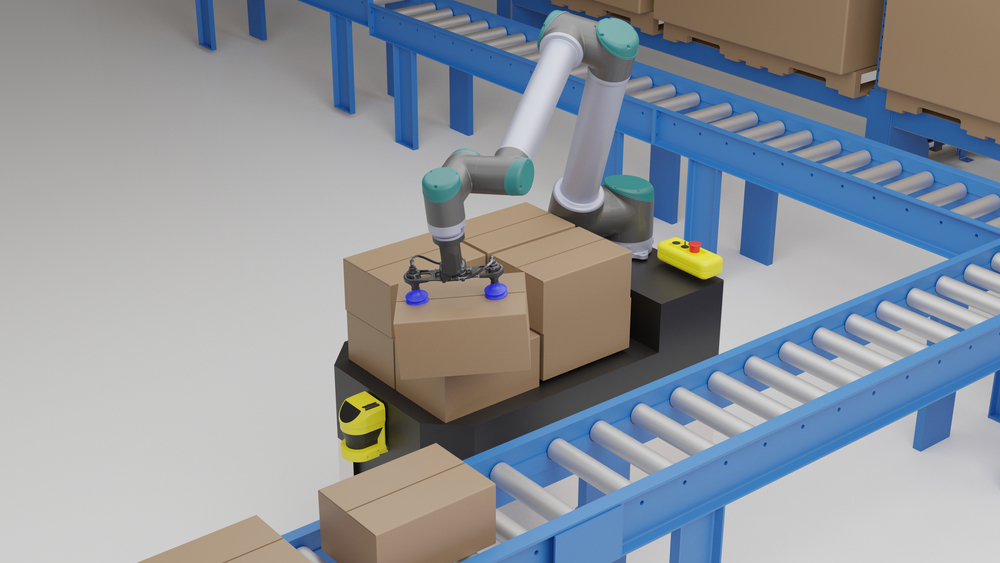
“Let the robots do the traveling.” Studies show that many people in warehouses spend as much as 60% of their time traveling. The same is true for some people in factories. They might be pushing a cart or driving a forklift. It’s easy to see this is not a high-value activity. So, mobile robots are being used to solve this problem. The idea is for the people to stay in one place and let the robots do the traveling.
Some of the standard applications for AMRs include:
- Order picking
- Intra-facility material transport
- Sorting
- Delivery to customers
We now take a closer look at each of these applications.
Order Picking
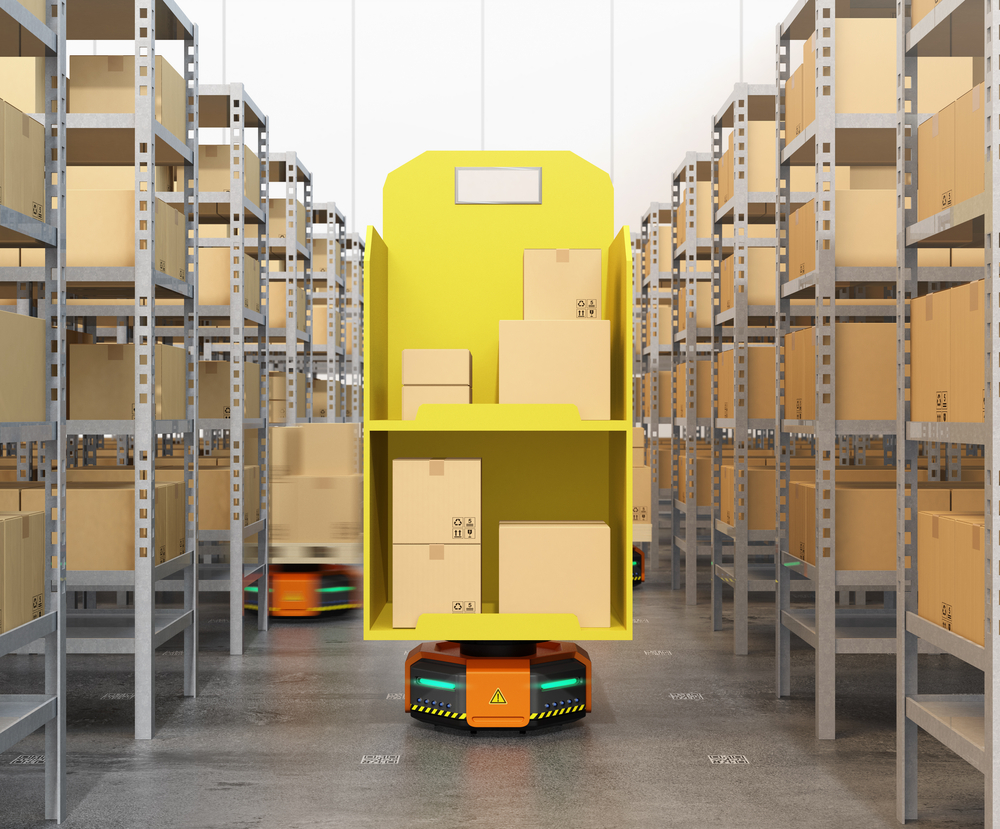
Mobile robots can make a huge difference by helping people with order picking. And help is needed. E-commerce means orders with a wider selection of products. And the order sizes are smaller. Sometimes, the order is only one item. This combination makes the order-picking process more labor-intensive. In addition, customer expectations for rapid delivery have skyrocketed. Amazon has set the standard with two-day delivery. Recently, Amazon began to offer one-day delivery.
Amazon has poured huge investments into robotics to achieve this result. Can smaller companies compete with this? Happily, the answer is yes. Cost-effective mobile robots provide a solution. Even smaller firms can slash the time it takes to get an order out the door by using AMRs.
One key question must be asked at the beginning when you consider using AMRs for order picking. And that is, what is the best way for your people to collaborate with the robots? Choosing this strategy will often determine the choice of robot. That is, the choice is not so much about the robot as it is about the nature of the solution.
Here are a few of the most popular strategies for human-to-machine collaboration.
Goods-to-Person Order Picking
Millions of people have seen YouTube videos of orange, low-slung Amazon AMRs. The robots carry entire shelves of products around a warehouse. This method of automation is called goods-to-person. The robots are controlled by the Warehouse Management System (WMS). The WMS tells the robots which shelves to pick up and where to place them. This is based on orders that need to be fulfilled. The AMR travels to a shelf and lifts it up from below. The AMR carries the shelf to people who are positioned at picking/packing stations. When the shelf arrives, a display instructs them which item to pick and the quantity. The associate removes the correct items from the shelves. They scan the barcodes and place the items into a container for shipping.
Amazon has enjoyed great success using this goods-to-person strategy. Yet, it requires special shelving. And the warehouse must be redesigned to use this strategy.
“Meet me” or Zone Picking
Using this strategy, an order-picking person handles one or two aisles or a zone. They don’t have to travel outside their zone. The AMRs do most of the traveling.
The AMRs are told by the WMS where to go, according to the orders that need to be fulfilled. The robot travels to a shelf where the item is to be picked. The order-picking person can be informed by a voice system that gives instructions on where to go to pick the next order. The worker meets the AMR at the pick location, and the AMR shows the person the items to be picked on its display. The person picks the items from the shelves and scans them with a barcode reader mounted on the robot. This verifies the right product and quantity have been picked. The AMR then travels to its next destination. The person waits for instructions on where to meet the next AMR.
Using this strategy, the order-picking person still must do some walking, but it is greatly reduced.
Case studies show at least a doubling in productivity using the zone picking strategy. Some studies report a more than tripling in orders picked per hour using this method in comparison with manual order picking.
Fully automated order picking
Fully automated order picking is sometimes called the “Holy Grail” of robotic order picking. This process uses robots to pick items from the shelves and carry them to a packing station. The packing station also uses robots. No people are needed. This level of automation is still in its early stages and is not yet widely used.
A hybrid solution for fully automated order picking uses an AS/RS and robots. The Automated Storage and Retrieval System (AS/RS) can replace the conventional shelf-and-aisle arrangement of a warehouse. Instead, the system is in the form of a vast cube, with products stored in bins inside the cube. The AS/RS keeps track of where things are and can bring the right product bin to the robotic picking station. Such systems can be made quite compact. This means they can be in the rear of a grocery store, for example.
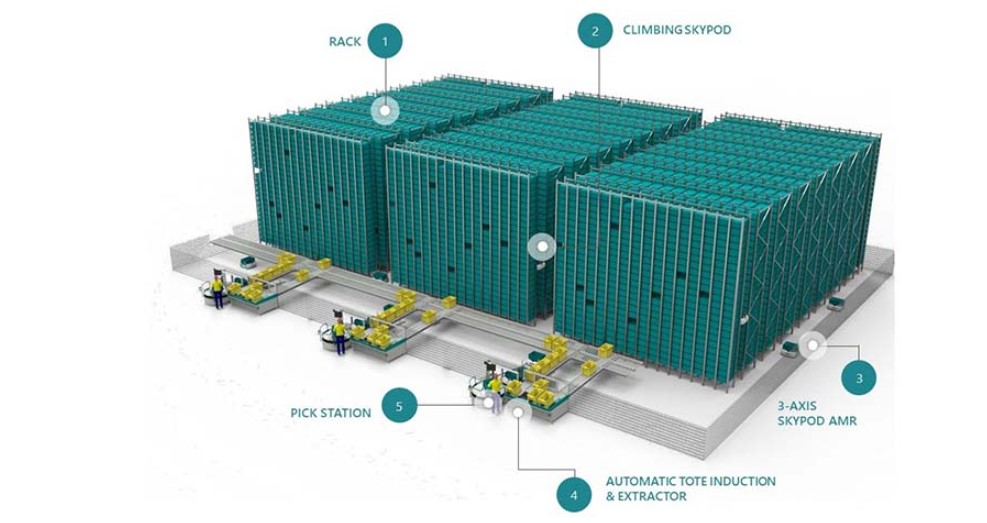
Once the AS/RS presents a bin with products, a person or a robot arm picks items out of the bin and places them into a shipping container. To be able to perform this function, the robot arm must be paired with advanced computer vision.
Further improvements in robotics will soon make fully automated order picking practical for a wider variety of use cases.
Intra-facility material transport
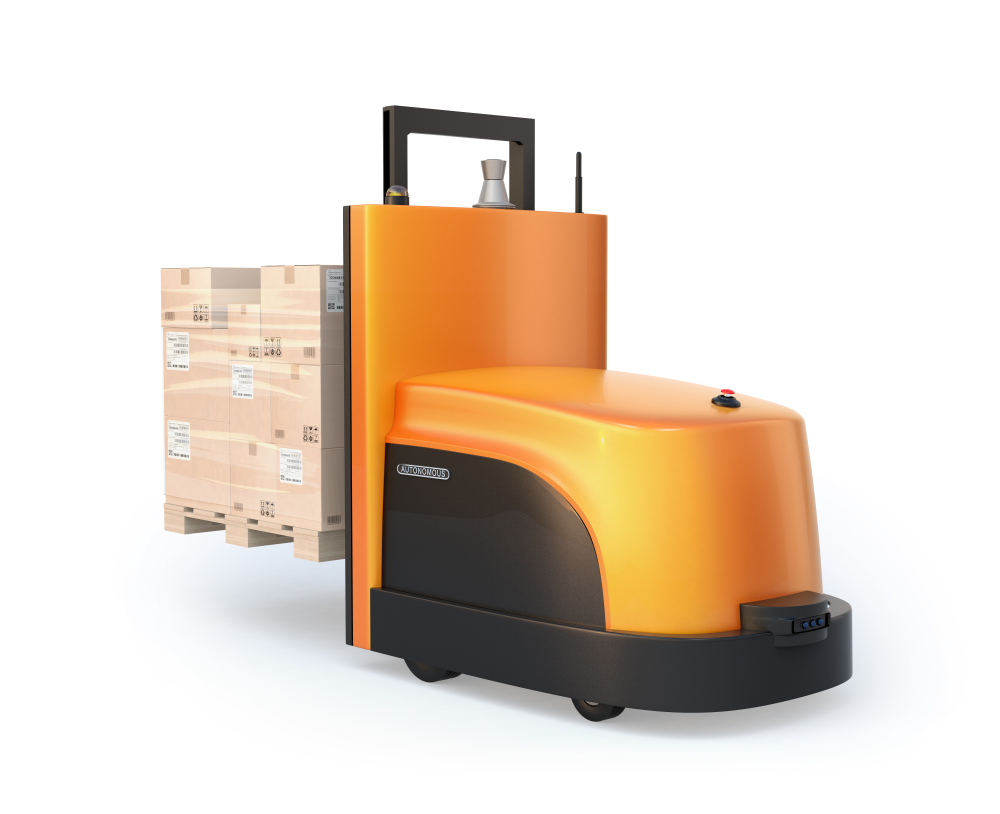
Factories and Warehouses
Autonomous forklifts are increasingly used in the factory and warehouse environment. Some automated forklifts use AGV technology. This requires the facility to become equipped with pathway markers on the floor. Other self-driving forklifts use the full AMR technologies that don’t need such markers. There are automated forklifts that are designed to operate either with a driver or without. Other designs remove the cab that would hold a human.
Automated forklifts increase productivity by freeing people from the need to do the driving. And the promise is that autonomous forklifts will also improve safety. Forklift and industrial truck accidents cause thousands of injuries per year. In recent years, the number of fatalities and serious injuries involving forklifts has been increasing. Most of these accidents are caused by driving too fast, cornering too quickly, and braking too hard. Automated forklifts would not make these mistakes.
Hospitals
There are AMRs specially designed for hospitals. They transport soiled linens from hospital rooms to the laundry. They can carry blood samples from where the sample is taken to the laboratory for testing. And AMRs can deliver meals and medications to the hospital room. Case studies show delivery costs can be reduced by as much as 80%.
Hotels and Hospitality
AMRs can fulfill guest requests for extra towels, toiletries, and food. Security can be enhanced by having outside food services deliver to the lobby. The AMR takes the food from the lobby to the guest’s room. Carrying soiled linens to laundry and returning empty plates to the kitchen can be automated, too.
Sorting
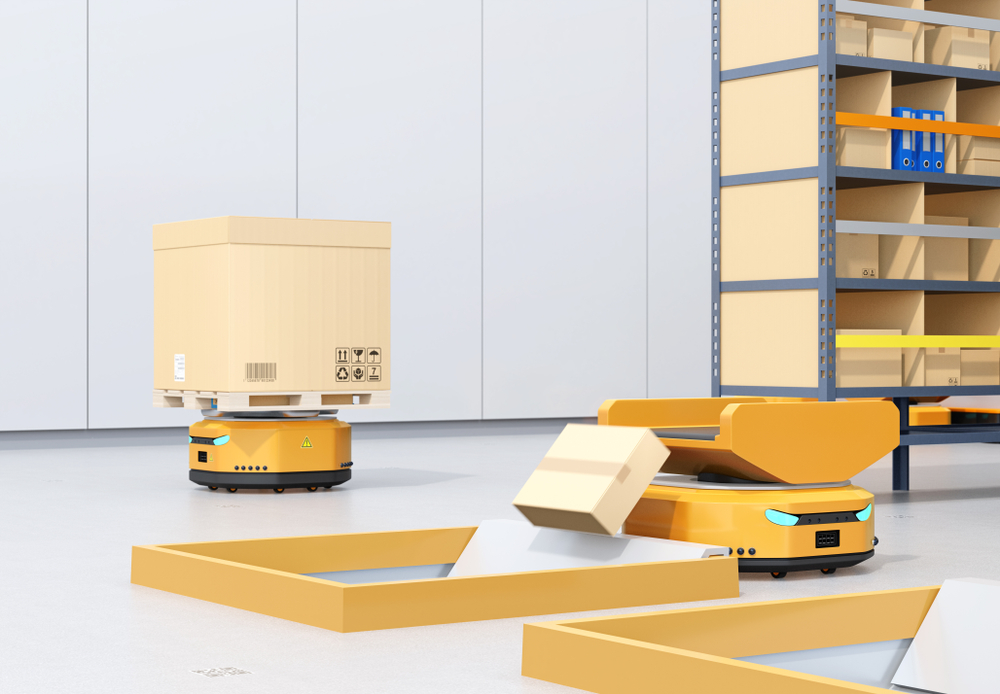
Mobile robots equipped with tilt trays and cross-belt feeders are used to sort packages in warehouses and factories. Sorting packages for shipment enables the shipper to access lower shipping rates. Or the packages might need to be sorted according to which retail outlet they need to go.
AMRs are increasingly seen as a more flexible and cost-effective alternative to conveyor systems. They are easy to install and need minimal maintenance.
Some sorting applications involve AMRs that operate on a mezzanine level. Once loaded with a package, the robot takes it to a hole in the floor and dumps it in. A chute leads to the first floor and a waiting container.
Other applications involve the AMR bringing products to a put wall. A person takes the products from the AMR and puts them into appropriate bins.
Delivery to customers
Having an AMR show up on your doorstep with packages for you is coming soon. Yet, until self-driving vehicles are licensed to travel on public roads, delivery robots will only be used in limited areas. For example, delivery robots are being used in densely populated urban areas for food delivery. The robots are small carts that travel along sidewalks. College and corporate campuses are another use case.
Industries for AMRs
Autonomous Mobile Robots will undoubtedly continue to find their way into more aspects of our daily lives. Here are the main industries presently using AMRs:
- Warehouses
- Factories
- Hospitals
- Hotels & Hospitality
- Restaurants and Fast Food
Checklist: Five Indicators that You Can Benefit from Mobile Robots in Your Business
- Is it a challenge to hire and keep the people you need?
- Do your processes involve a lot of people traveling around inside your facility?
- Do you need to increase productivity to stay competitive?
- Do you need to increase throughput?
- Do you want to reduce accidents and improve safety?
What Should You Consider if You Want to Invest in Mobile Robots?
Before you get started on a project to use AMRs, you should do a facility survey. Here are some of the questions to ask:
- Do you have Wi-Fi throughout your facility? (For example, if the AMR has to take the elevator, will it have access to Wi-Fi there too? Could there be other dead spots?)
- Can the AMR go wherever it needs? (For example, will it need to open doors or take an elevator?)
- What are the safety considerations? (For example, a warehouse robot won’t be around children. Delivery robots will).
- What about charging? Think about where you need to put the charging station.
If you’re new to industrial robotics, many experts recommend starting small. Select an application that promises a rapid ROI. Build up your experience and confidence, and then expand.
You can rely on the vendors to make recommendations. Naturally, vendors will make suggestions that involve the use of their products. You might consider consulting with impartial experts to get advice – and for assessing if your facility is “mobile robot-ready”.
What Complementary Solutions Are Often Needed With Mobile Robots?
Often the issues to be decided are not so much about the robot. Instead, the real question is the overall application solution. This is because the robots are frequently embedded within a larger framework. A Warehouse Management System (WMS) and other similar systems that control the robots are as important as the features of the robot.
Make sure you understand how the mobile robots will integrate into your existing systems.
For material handling, AMRs will often need a special mount for pallets or boxes. The AMR goes underneath the mount and then lifts the load from below.
You need at least one and maybe several charging stations. Consider the case in which several AMRs need to charge at the same time.
How to Source the Ideal Mobile Robot for Your Organization
HowToRobot is a global platform helping companies to succeed with automation. We have a worldwide directory of over 15,000 robotics companies. This means you can find the type of mobile robot you need, ideally suited for your application.
If you are looking for a mobile robot solution, you can get tailored proposals from a variety of suppliers. Simply describe your project and start receiving answers.
For sourcing only the mobile robot or related components, you can get quotes and receive product information and pricing from many vendors.
Please note there are impartial HowToRobot experts who can help you navigate through the process. Click here to set up a consultation with an expert advisor.
